Updated: 21-Oct-2020
Well-known brand of rotary engines, founded around 1910-11 by Arts and Crafts (Arts et Métiers) Engineer M. Louis Verdet.
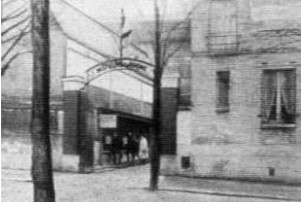
“Le-Rhone factory”
-He set up the factory on Passeig Kellermann No. 68 in Paris. Its engines followed the line of the “Verdet” engine, later known as the Le-Rhone B2. The Le-Rhone are distinguished by having a double valve, with intake and exhaust at the cylinder head, also for its intake duct, from the central crankcase to the inlet of the intake valve.
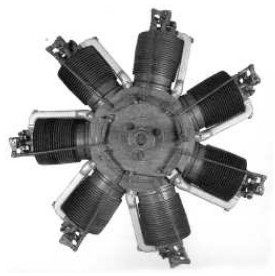
“Le-Rhone B2 - Verdet”
-This duct is the most differentiating fact to distinguish them at first glance from Gnome engines. Generally it was made of red copper (cuivre rouge).

“Le Rhone B, at the Safran Museum”
-The B engines had 7 cylinders, they were the only ones with this number of cylinders. From 1912 it is the one we have shown, without one cylinder and there also are no intake ducts. A demo at the Safran museum in Villaroche. This engine gave 50/60 CV.
-The basic production of the Le-Rhone engines were 9-cylinder engines. They were known with the nickname “Rototos”.
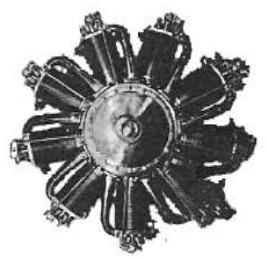
“9C”
-The 9-cylinder, 9C model was the first of the C, D and E series that went into production.

“Le Rhone 9C, rear view”
-They gave 80 CV (or 90 CV, depending on the application). The 9C's cylinders were 105 mm bore and 140 mm stroke.
-The 9Js were more successful, with 110 CV (120 CV sometimes). They were 112 x 170 mm. Around 1915 it was absorbed by Gnome, both becoming known as Gnome-Rhone.

“9J”
-They had a great application and in turn were built under license in many countries.
-In England by W.H. Allen and Bedford. In Sweden by Thulin. In Germany by Oberursel and in the USSR as M-2. See chapters of all of them.
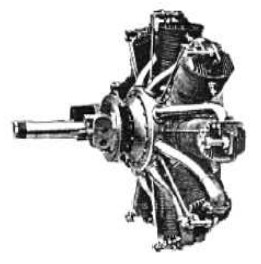
“9J, rear-side view”
-The set-up was carried out on trestles with graduated sectors.

“Engine set-up”
-Below are some diagrams of the connecting-rod arrangement that are installed inside grooves formed by the two halves of the crankshaft main bearing.
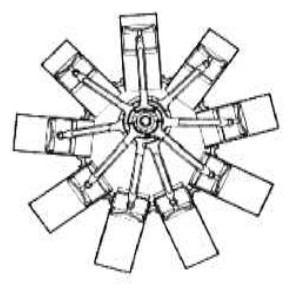

“connecting-rod system”
-The crankshaft is always fixed and with the crank at 12 o'clock.
-The carburetor is located at the end of the rear crankshaft extension, passing the mixture through its interior to the crankcase.
-The attachment to the structure of the plane was by that hollow shaft and by some plates.
-See the long rear shaft that has at least two attachment points in the following two illustrations.

“9J, rear view”

“9J, stem-bracket”
-At the end of the hollow stem, which at the same time supports the engine to fix it to the structure, we see the carburetor. The mixture will follow this conduit to the interior of the crankcase from where it will be distributed by centrifugation towards the cylinders.
-The 9Jb gave 120 CV and was built in 1917. It had 15 liters of total displacement. The power delivered at 1,250 rpm.

“9 Jb” (PiP)
-The 9Jb is shown here with a sectioned wooden propeller. The 9Jby gave 135 CV.
-With 9-cylinder engines different prototypes were made as shown below with three valves per cylinder, two intake and one exhaust. We can see the double intake duct for each cylinder.
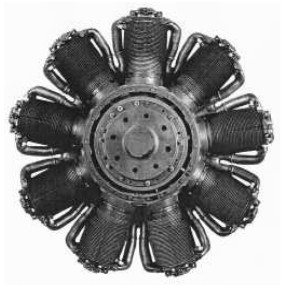
“Prototipo from 1917” (PiP)
-Another prototype, but from the year 1916, was a 9-cylinder that gave 200 CV at 1,300 rpm with 27 liters of displacement.
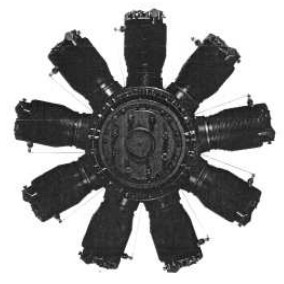
“Prototipo from 1916” (PiP)
-The L model gave 130 CV but did not reach the level of the J. The same as the M, with 200 CV at 1,300 rpm.
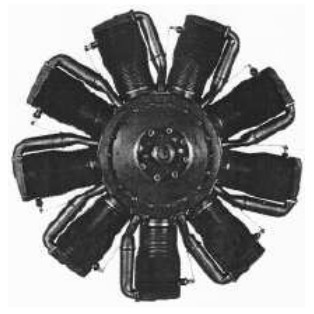
“Le-Rhone, L model” (PiP)
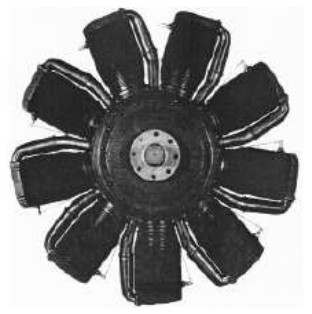
“M Model” (PiP)
-The R model, also the fruit of the Great War, was a 170/180 CV, nine-cylinder at 1,360 rpm. Compared to the J, it had a higher compression ratio, aluminum pistons, a new intake system, better internal cooling and double ignition.
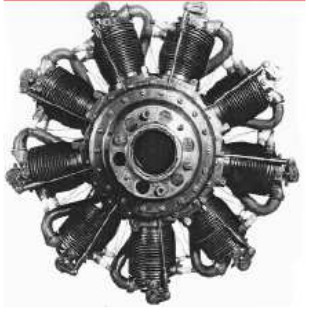
“Z/60 model”
-The first Z model was small, with 7 cylinders and giving 40/65 CV, depending on the application. The Z / 60 was a 9-cylinder, 60 CV engine and was designed for civil aviation. That power was achieved at 1,450 rpm. The cylinders were 84 x 106 mm.
-There was a 14 cylinder of 120 CV, as well as the 18 cylinder giving 160 CV that we show below, Model E from 1913.
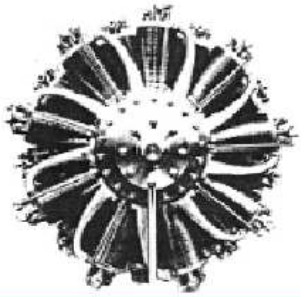
“18 cylinders, 160 CV”

“18 cylinders, 340 CV”
-The 18 cylinder presented above was major giving 340 CV at 1,200 rpm with a total displacement of 31.8 liters. The cylinders measurements were 115 mm bore by 170 mm stroke. It was built around 1917.
-Below we show the time-damaged remains of a 28-cylinder engine, in four rows of seven cylinders each. It gave 320 CV and was a prototype that was built in 1918.
-No application is known because it showed a strong inertia of the rotation group as well as an enormous torque that would make the airplane ungovernable.
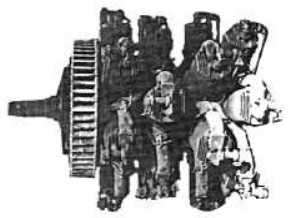
“Le-Rhone, 28 cilindros”
-It displaced almost 35 liters. It had a fan attached to ensure cooling of all cylinders.
-We now have a photograph of another engine of the same type, restored and exhibited at the Safran Museum in Villaroche.
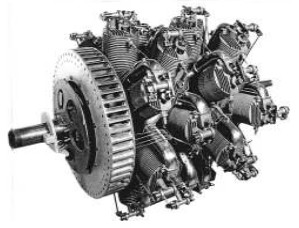
“The 28-cylinder at Villaroche” (PiP)
From Appendix 6: Below we show a recently received image of the 80 CV rotary engine with 9 cylinders. A simple version of the 160 CV, 18-cylinder engine mentioned in the main text.
-It has been considered to insert it for the beauty of its individual intake manifolds for each cylinder.
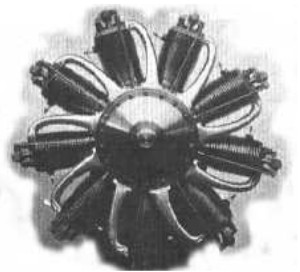
“Le-Rhone, 80 CV”
-The most striking use of Le-Rhone engines for us is the one done in Austria by Professors Petroczy and Karman.
-It was a captive helicopter for artillery surveillance, troop movement, etc.
-There is no doubt that the command post was a very critical place.
-The apparatus was built by the Austrian Airplane Factory Ltd. of Wiener-Neustadt.
-The first prototype used a 1,225 CV Daimler electric motor with a weight of 105 Kg.
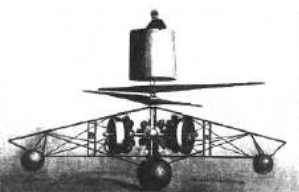
“Petroczy-Karman Captive Helicopter”
-Subsequently -and the one in the illustration- was made with three Le-Rhone engines coupled to the main mast driving two contra-rotating propellers.
-Information from a writing by Gerard Hartmann. He does not mention a small engine with two horizontally-opposed cylinders giving only 10 CV for small aircraft (aviettes). From the year 1921.

“Le-Rhone, 10 CV”
-The photo is from the Snecma-Moteurs files and it is mentioned that it is of Le-Rhone origin. It was built by Gnome-Rhone. In other words, after the merger of both companies.
-The 14-cylinder double-row rotary engine is shown below, along with another 18-cylinder with the same architecture.
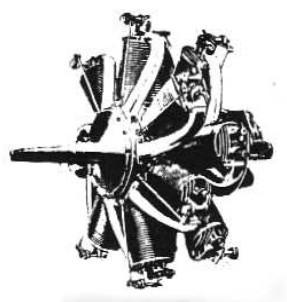
“Le-Rhone, 14-cylinder”
-It is the 220 CV, 14S model, in fact two 7B model engines, 26° offset (exactly 25.72°).
-This engine was overshadowed by the appearance of the much simpler 110 CV, 9J engine. Both were rotary engines.
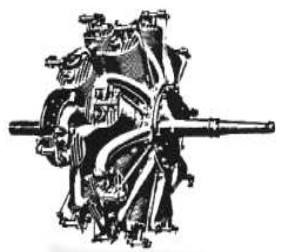
“Le-Rhone 18E”
-The 18E gave already 160 CV at 1,150 rpm. In fact two joined 9C motors and offset by 20°.
-Although rarely, they made 11-cylinder rotary engines like the 100 CV from 1913. It used 9C cylinders.

“11-cylinder Le Rhone engine”
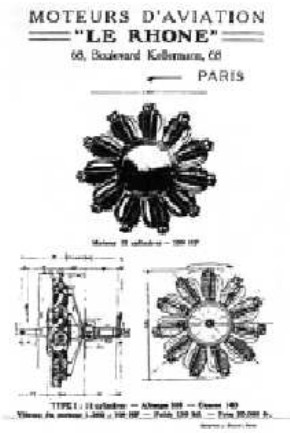
“Ad for thel 11-cylinder” (Snecma archive)
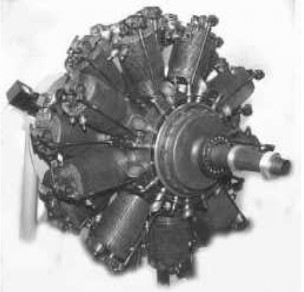
“Le Rhone 18R”
-The 18R is made up of two 9Rs. It gave 340 CV and is from the year 1918.
-The 9R gave 178/180 CV. From the year 1916. Below is an illustration from the manual with its dimensions.

“Le-Rhone 9R”
In the main text there is an in-line six-cylinder engine attributed to the Renault company. (certain). Once restored in Mataró, near Barcelona, belonging to the private collection of J. C., more logos have been seen on various parts of the engine.
One of them is LR-10 and several diamonds with the initials L and R in the center. It seems that it is not an almost unknown Le Rhone for airships - due to the ignition shielding. (Or marine, or industrial). See the Conservatoire Aeronautique d’Aquitaine page. Le Rhone 9C).
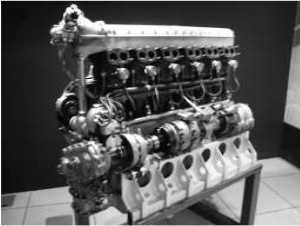
"Renault confused with Le-Rhone"

“LR-10 cast marks”
-After investigations and on-site checks, at AAMS, the same brands appear on a Renault Schneider competition. Finally it is the L and R of Louis Renault.
-In October 2012 we specified that it is a Renault Tank B-1 or B-1bis or B-1ter. Clearing the mystery.
Engines of LE - RHONE
Model: 11F
Arquitecture: 11-cylinder Rotary
Cooling: Air
Total Displacement:
Bore / Stroke:
Power: 100 CV
Weight:

"Le Rhone, 11 cilindros"
Model: 14D, 120 CV
Arquitecture: 14-cylinder Rotary
Cooling: Air
Total Displacement:
Bore / Stroke:
Power: 120 CV
Weight:
Model: 14S
Arquitecture: 14-cylinder Rotary
Cooling: Air
Total Displacement:
Bore / Stroke:
Power: 220 CV
Weight:

"Le-Rhone, 14 cilindros"
Model: 18E
Arquitecture: 18-cylinder Rotary
Cooling: Air
Total Displacement:
Bore / Stroke:
Power: 160 @ 1150 rpm
Weight:

"Le-Rhone 18E"
Model: 18R
Arquitecture: 18-cylinder Rotary
Cooling: Air
Total Displacement: 31800 cc
Bore / Stroke: 115 x 170
Power: 340 CV @ 1200 rpm
Weight:

"Le-Rhone 18R"
Model: 28E
Arquitecture: 28-cylinder Rotary
Cooling: Air
Total Displacement: 35 Ltr.
Bore / Stroke:
Power: 320 CV
Weight:

"Le Rhone 28 cylinders at Villaroche" (PeT)
Model: 7, 7-A
Arquitecture:
Cooling:
Total Displacement:
Bore / Stroke: x
Power:
Weight:
Model: 7B, 7B2
Arquitecture: Rotary
Cooling:
Total Displacement:
Bore / Stroke:
Power: 60 CV
Weight:

"Le-Rhone B2 - Verdet"
Model: 7C, 60 CV
Arquitecture:
Cooling:
Total Displacement:
Bore / Stroke: x
Power:
Weight:
Model: 7Z
Arquitecture: 7-cylinder Rotary
Cooling: Air
Total Displacement:
Bore / Stroke:
Power: 40 CV
Weight:
Model: 9C, 80 CV
Arquitecture: 9-cylinder Rotary
Cooling:
Total Displacement:
Bore / Stroke: 105 x 140 mm
Power: 80 CV
Weight:

"Le-Rhone 9C front view"
Model: 9J, 110 CV
Arquitecture: 9-cylinder Rotary
Cooling: Air
Total Displacement:
Bore / Stroke: 112 x 170 mm
Power: 110 CV
Weight:

"Le-Rhone 9J front view"
Model: 9Jb
Arquitecture: 9-cylinder Rotary
Cooling: Air
Total Displacement: 15 Ltr.
Bore / Stroke:
Power: 120 CV @ 1250 rpm
Weight:
The 9Jby gave 135 hp

"Le-Rhone 9Jb"
Model: 9R, 180 CV
Arquitecture: 18-cylinder Rotary
Cooling: Air
Total Displacement:
Bore / Stroke:
Power: 180 CV @ 1360 rpm
Weight:
Model: 9Z
Arquitecture: 9-cylinder Rotary
Cooling: Air
Total Displacement:
Bore / Stroke: 84 x 106 mm
Power: 60 CV @ 1450 rpm
Weight:

"Le-Rhone, Z/60 model"
Model: K
Arquitecture:
Cooling:
Total Displacement:
Bore / Stroke: x
Power:
Weight:
Model: L
Arquitecture: 9-cylinder Rotary
Cooling: Air
Total Displacement:
Bore / Stroke:
Power: 130 CV
Weight:

"Le-Rhone, L model" (PeT)
Model: M
Arquitecture: 9-cylinder Rotary
Cooling: Air
Total Displacement:
Bore / Stroke:
Power: 200 @ 1300 rpm
Weight:

"Le-Rhone, M model" (PeT)
Model: P
Arquitecture:
Cooling:
Total Displacement:
Bore / Stroke: x
Power:
Weight:
Model: R
Arquitecture:
Cooling:
Total Displacement:
Bore / Stroke: x
Power:
Weight:


